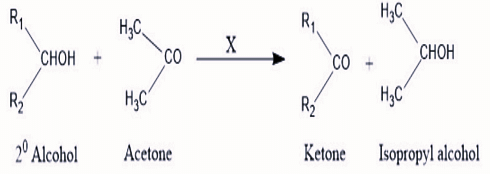In the following compounds, what is the increasing order of their reactivity towards nucleophilic addition reactions?
- Benzaldehyde $<$ p-Tolualdehyde $<$ p-Nitrobenzaldehyde $<$ Acetophenone
- Acetophenone $<$ Benzaldehyde $<$ p-Tolualdehyde $<$ p-Nitrobenzaldehyde
- Benzaldehyde $<$ Acetophenone $<$ p-Tolualdehyde $<$ p-Nitrobenzaldehyde
- Acetophenone $<$ p-Tolualdehyde $<$ Benzaldehyde $<$ p-Nitrobenzaldehyde
The Correct Option is D
Approach Solution - 1
The reactivity of carbonyl compounds towards nucleophilic addition is influenced by two main factors: the electron-withdrawing effect and steric hindrance. Elecron-withdrawing groups increase reactivity by making the carbonyl carbon more electrophilic, while steric hindrance can decrease reactivity. Let's analyze the provided compounds:
| Compound | Factors Influencing Reactivity |
|---|---|
| Acetophenone | Presence of an electron-donating alkyl group reduces the electrophilicity of the carbonyl carbon, decreasing reactivity. |
| p-Tolualdehyde | A methyl group on the benzene ring is slightly electron-donating, which makes it less reactive than benzaldehyde but more reactive than acetophenone. |
| Benzaldehyde | Without additional electron-donating groups, it's more reactive than acetophenone and p-tolualdehyde but less reactive than p-nitrobenzaldehyde. |
| p-Nitrobenzaldehyde | The nitro group is a strong electron-withdrawing group, increasing the reactivity of the carbonyl carbon the most. |
Based on these factors, the increasing order of reactivity towards nucleophilic addition reactions is as follows:
Acetophenone < p-Tolualdehyde < Benzaldehyde < p-Nitrobenzaldehyde.
Approach Solution -2
As discussed in the previous response, the reactivity towards nucleophilic addition reactions depends on the electronic and steric effects of the substituents on the carbonyl group.
Let's reiterate the analysis:
Benzaldehyde (C6H5CHO): A simple aromatic aldehyde.
p-Tolualdehyde (p-CH3C6H4CHO): The methyl group (CH3) is electron-donating, decreasing reactivity.
p-Nitrobenzaldehyde (p-NO2C6H4CHO): The nitro group (NO2) is electron-withdrawing, increasing reactivity.
Acetophenone (C6H5COCH3): A ketone with steric hindrance and electron donation from the methyl group, decreasing reactivity.
The electron-withdrawing nitro group in p-nitrobenzaldehyde makes it the most reactive, while the electron-donating methyl group in p-tolualdehyde reduces reactivity. The ketone, acetophenone, is the least reactive due to steric hindrance and electron donation from the methyl group. Benzaldehyde is intermediate in reactivity.
Therefore, the increasing order of reactivity is:
Acetophenone < p-Tolualdehyde < Benzaldehyde < p-Nitrobenzaldehyde
The correct answer is:
Option 4: Acetophenone < p-Tolualdehyde < Benzaldehyde < p-Nitrobenzaldehyde
Top Questions on carbonyl compounds
- Which of the following are neutral?
- KEAM - 2025
- Chemistry
- carbonyl compounds
- Acetone can be converted to 2-methylpropan-2-ol using:
- KEAM - 2025
- Chemistry
- carbonyl compounds
- The correct stability order of carbocations is
- JEE Main - 2024
- Chemistry
- carbonyl compounds
- According to Oppenauer Oxidation reaction, oxidation of secondary alcohol to ketone by reagent (X) in acetone takes place, what is "X" :

- GPAT - 2024
- Organic Chemistry
- carbonyl compounds
- The Gattermann-Koch reaction is used in the industrial preparation of benzaldehyde. The electrophile involved in this reaction is
- CUET (UG) - 2024
- Chemistry
- carbonyl compounds
Questions Asked in CUET exam
- A person walks 10 m North, then turns right and walks 5 m, then turns right again and walks 10 m. What direction is he facing now?
- CUET (UG) - 2025
- Direction sense
- Which of the following is a polysaccharide?
- CUET (UG) - 2025
- Biomolecules
- A train crosses a platform 200 m long in 36 seconds and a pole in 18 seconds. Find the speed of the train.
- CUET (UG) - 2025
- Speed, Time and Distance
- If \( 3 \times 4 = 25 \), \( 5 \times 2 = 27 \), \( 6 \times 3 = 39 \), then what is \( 7 \times 5 = ? \)
- CUET (UG) - 2025
- Logical Reasoning
- A and B can complete a task in the ratio 3:2. If together they complete the task in 20 days, how long will A alone take?
- CUET (UG) - 2025
- Time and Work